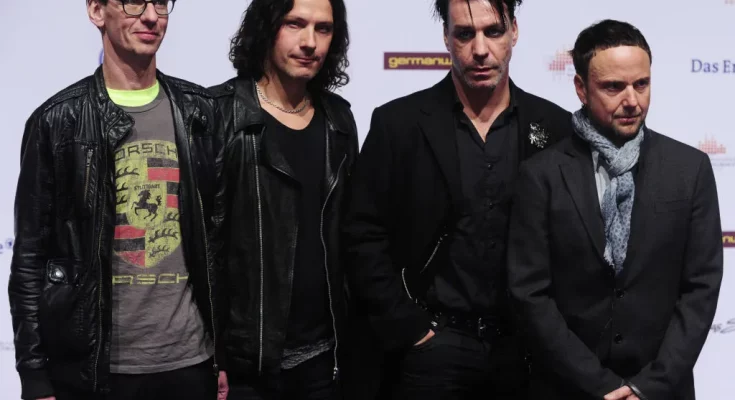The controversy surrounding Rammstein has once again ignited a heated public debate in Germany, as their music video for the song “Deutschland” resurfaces in the spotlight, with renewed calls for censorship and restrictions due to what critics describe as “historically irresponsible” imagery. Originally released in 2019, the video was already one of the most provocative productions in modern German music history, intertwining the band’s dramatic artistic approach with some of the darkest chapters of Germany’s past. At the center of the controversy lies Rammstein’s unapologetic use of concentration camp visuals, militaristic themes, and provocative re-enactments of moments that remain deeply sensitive in German collective memory. The debate, which had simmered in recent years, has now reignited with new intensity as politicians, cultural commentators, and historians weigh in on whether such representations cross the line between artistic freedom and dangerous trivialization.
When the video first dropped, its impact was immediate and polarizing. In typical Rammstein fashion, the production was both cinematic and unsettling, combining high-quality visuals with provocative narratives that span centuries of German history, from medieval wars and imperialism to the Weimar era, the Third Reich, and the divided Germany of the Cold War. For supporters, the video was an artistic masterpiece that challenged viewers to reflect on the complexities of German identity, confronting the country’s past rather than whitewashing it. For critics, however, the imagery of band members dressed as concentration camp prisoners with nooses around their necks, juxtaposed with Nazi officers and acts of violence, went too far, sensationalizing some of the most painful historical realities in a way that bordered on exploitation.
The new wave of outrage has been triggered by a broader cultural climate in Germany, where debates about historical memory, nationalism, and the limits of artistic expression have intensified. Politicians from across the spectrum have spoken out. Some conservative voices argue that Rammstein’s portrayal of Nazi crimes in a music video format risks trivializing the Holocaust and dishonoring its victims. They emphasize that Germany has a unique responsibility to maintain dignity and respect in how its darkest era is represented. On the other side, advocates for free expression argue that censorship is a dangerous path, and that art, even when offensive or uncomfortable, plays a vital role in sparking dialogue and preventing historical amnesia. This tension reflects a broader cultural struggle within Germany: how to balance remembrance and responsibility with the freedom to confront, critique, and even shock.
The band itself has long been no stranger to controversy. Since their rise in the 1990s, Rammstein has deliberately blurred the line between provocation and offense. Their stage performances are infamous for their pyrotechnics, violent imagery, and sexual themes, often designed to shock audiences and challenge taboos. Critics have accused them of flirting with fascist aesthetics by using militaristic imagery, while the band has consistently denied any ideological sympathies, framing their work as satire or commentary. In the case of “Deutschland,” the band maintained that the video was not meant to glorify or trivialize, but to hold a mirror to the nation’s history—both its triumphs and its horrors. Nevertheless, perception is everything, and for many viewers, the imagery crossed a line that should not be crossed.
The renewed calls for censorship have come at a time when Germany is grappling with rising political extremism, both on the far right and far left, as well as an ongoing societal debate about collective memory. With far-right parties gaining more visibility in elections and extremist rhetoric appearing in public discourse, critics argue that works like Rammstein’s “Deutschland” risk being misappropriated by groups who might strip away the nuance and use the imagery to fuel their own agendas. Holocaust remembrance organizations have echoed this concern, stressing that popular culture must tread carefully when dealing with symbols and imagery that have such heavy historical weight. The fear is not necessarily that Rammstein supports such ideologies, but that their provocations could be weaponized or misunderstood in a cultural landscape already strained by division.
Censorship debates in Germany carry particular sensitivity because of the country’s postwar emphasis on free expression as a democratic safeguard against authoritarianism. The Basic Law protects artistic freedom, and courts have historically sided with artists in controversial cases, recognizing that art often requires provocation to make its point. At the same time, Germany also has some of the strictest laws in the world regarding hate speech, Nazi symbols, and Holocaust denial, reflecting its special responsibility to prevent the return of fascist ideologies. This legal and cultural tension has created a unique landscape in which Rammstein operates, where their work is legally permissible but culturally explosive. Calls for censorship are not just about legality, but about moral responsibility and societal impact.
Supporters of the band argue that the very purpose of the “Deutschland” video was to provoke thought and force viewers to confront uncomfortable truths. Rather than sanitizing history, Rammstein put it front and center, refusing to let audiences forget or ignore it. They argue that art should not be judged by whether it offends, but by whether it provokes meaningful reflection. In this view, the controversy itself is proof of the video’s success, sparking debates about memory, identity, and responsibility. Many fans also note that the video ends on an ambiguous note, neither glorifying nor celebrating the dark aspects of history, but presenting them as part of a broader narrative about a nation wrestling with its identity. To censor or ban such work, they argue, would be to silence difficult but necessary conversations.
The broader public remains divided. For younger audiences, especially those less directly connected to the generational trauma of World War II, the video may be viewed more as a bold artistic statement than a dangerous trivialization. For older generations and those with personal or familial ties to Holocaust survivors, the imagery is far more painful and fraught with risk. This generational divide adds another layer to the controversy, highlighting how memory and trauma are experienced differently across time. It also underscores the challenge of crafting cultural works in Germany that speak to multiple audiences with vastly different sensitivities.
Beyond the immediate controversy, the debate over Rammstein’s “Deutschland” also reflects larger questions about the role of popular culture in shaping national memory. Music videos, concerts, and performances reach audiences that history books and memorials often do not. As such, artists have immense power in shaping how younger generations perceive and engage with history. This power comes with responsibility, and critics argue that Rammstein has wielded it recklessly, prioritizing shock value over sensitivity. Supporters counter that without shock, the message might never break through the noise of modern entertainment. The clash between these perspectives is unlikely to be resolved, as it touches on fundamental disagreements about art, memory, and morality.
Calls for censorship are unlikely to succeed legally, given Germany’s protections for artistic expression, but they are likely to influence public discourse and cultural reception. Some broadcasters and platforms may choose to restrict or label the video, while educators and commentators may continue to use it as a case study in the ethics of representation. For Rammstein, the controversy only reinforces their reputation as cultural provocateurs, artists who thrive on walking the fine line between art and offense. Whether that reputation serves as a badge of honor or a mark of irresponsibility depends largely on one’s perspective.
As Germany continues to grapple with its past and its present, the Rammstein “Deutschland” controversy serves as a reminder that history is not just about what happened, but about how it is remembered, represented, and contested in the cultural sphere. For some, the video is a bold confrontation with history, a refusal to look away. For others, it is an irresponsible exploitation of pain and trauma for artistic or commercial gain. What is clear is that the debate itself reflects the ongoing struggle within Germany to navigate its unique historical burden while upholding the principles of free expression and artistic creativity. In the end, the scandal surrounding “Deutschland” is less about a single music video than about the enduring tensions at the heart of German identity: between memory and forgetting, responsibility and freedom, reverence and provocation. Rammstein, whether intentionally or not, has once again forced the nation to wrestle with those tensions in full view of the world.



